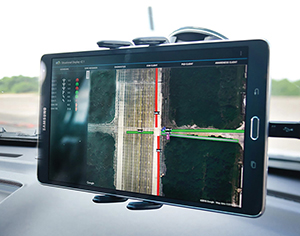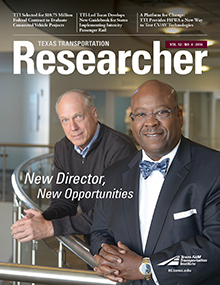Self-driving cars. Seamless communication between vehicles and the roadside. The ability to multitask while driving from point A to point B reliably, safely and on time.

It all sounds a bit like the George Jetson future we were promised in the 1960s, minus the flying cars. The difference is that the connected vehicle/automated vehicle (CV/AV) revolution is happening now. But to help make it a reality, the technologies need to be vetted, validated and successfully deployed. And before that can happen, we must have a reliable, standardized way to test those technologies.
The Texas A&M Transportation Institute (TTI) has developed an augmented-reality environment where real entities (e.g., vehicles and traffic signal operation) are combined with simulated traffic and displayed on a screen. This is similar to a Pokémon Go app, but instead of showing Pokémon, the screen shows simulated vehicles superimposed on the roadway. The first-of-its-kind approach — called CONVAS (CONnected Vehicle Assessment Simulation) — marries the cost-effectiveness of computer simulation with actual roadway operations to produce an efficient yet dependable evaluation mechanism for the Federal Highway Administration (FHWA). TTI has been developing the platform since January 2014.
“The limitations of traditional simulation come from having to model every entity to be as realistic as possible,” explains TTI Research Engineer Srinivasa Sunkari, principal investigator on the project. “For example, operating agencies can assess CV applications using a simulation environment that can accurately represent a mix of real vehicles with simulated vehicles simultaneously in real time.”
To mitigate the effects of modeling while improving reliability under actual driving conditions, Sunkari and his team used hardware-in-the-loop (HITL) simulation. This approach introduces hardware components into the simulation model. In HITL, devices like traffic signals are fed information (e.g., simulated data indicating a vehicle is passing a detector), and the signals react in real time. That reaction is then fed back into the simulation model, and the simulated vehicle proceeds or stops accordingly.
Sunkari and his team developed an enhanced HITL simulation in this project by incorporating an actual CV on a roadway network into a simulation model and displaying simulated CVs inside the real vehicle at the same time. This enables development and testing of advanced CV applications or strategies by allowing assessments of how CVs respond to each other. This is the first time HITL simulation has been applied in this way.
To more accurately represent CV communications, TTI researchers integrated the commercial microscopic traffic simulator VisSim with the open-source wireless network simulator ns-3. Doing so enables simulated vehicles to adapt to variability in the communication environment, providing a more realistic assessment of CV applications in the simulation model. Similar to its application of HITL simulation, TTI’s integration of the two simulators had also never been done before.
“CONVAS provides the most advanced, realistic evaluation tool for emerging CV/AV applications that rely on wireless communications,” says Sunkari. “And in the future, that’ll be just about every aspect of our transportation system.”
On June 22, 2016, Sunkari and his research team demonstrated CONVAS to visiting FHWA sponsors at The Texas A&M University System’s RELLIS Campus. The field test confirmed the successful integration of the Vissim and ns-3 simulators and showed the seamless data flow between the simulation model and the test vehicle’s onboard unit.
With the delivery of CONVAS in December, FHWA now has a way to test the realistic impact of wireless communications on the performance of large-scale CV applications while minimizing evaluation costs. Through simulation, technologies can be fine-tuned, and engineers can use the results to design advanced algorithms that, in turn, will govern how vehicles drive tomorrow’s roadways. In short, thanks to CONVAS, the wireless solutions connecting our future transportation system will be safer, more dependable and less expensive to build.
“The technology used in developing this platform will bring benefits in CV research for many years to come as we work to improve our transportation network to become a more intelligent, more reliable and safer system,” says FHWA Highway Research Engineer Peter Huang, who manages the Turner-Fairbank Intelligent Intersection Traffic Control Laboratory.

